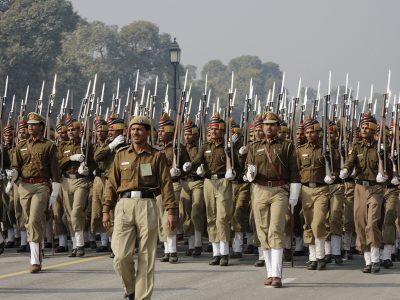India’s ‘Military Diplomacy’ Has Been a Mixed Bag of Success

India’s practice of “military diplomacy” in holding joint drills with a variety of Great Powers and regional states has been a mixed bag of success since the former has resulted in sending positive signals about “multi-alignment” while the latter risks fueling the fears of the domestic political opposition in those states that the South Asian country is subordinating them as “junior partners” in its regional hegemonic vision.
There’s been quite a lot of discussion in Indian media over the past week about the country’s latest practice of “military diplomacy” in holding joint drills with a variety of Great Powers and regional states. The country just concluded its first-ever tri-service exercises with the US and is slated to hold similar ones with Russia next month. December will also see the South Asian state conducting anti-terrorist drills with China too, during which time it’ll begin holding others with regional countries such as Nepal, Bangladesh, Sri Lanka, and Myanmar in the December-February time frame according to The Times Of India. That publication also noted that “India is the only country that holds exercises with all the P-5 countries (US, Russia, China, France and UK), apart from others like Australia, Japan, South Africa and Brazil as well as Asean countries like Singapore, Vietnam, Malaysia, Indonesia and Thailand”.
It’s therefore self-evident that India is flexing its military muscles across the world, and doing so with the intent of deriving some diplomatic advantages because of it (“military diplomacy”). This has been a mixed bag of success, however, since holding joint drills with the aforementioned Great Powers sends positive signals about its policy of “multi-alignment”, whereas doing so with the states of South Asia risks fueling the fears of the domestic political opposition in those countries that India is subordinating them as “junior partners” in its regional hegemonic vision.
The first-ever tri-service exercises with the US promoted the Indian military’s interoperability with their American counterparts, a trend that’s becoming increasingly impactful in the grand strategic sense following the progress that’s been made on concluding several so-called “foundational agreements” such as LEMOA and COMCASA, among the others that are still being negotiated like the Industrial Security Annex (ISA). India is striving to position itself as the US’ top military partner on the Asian mainland, to which end it hopes to convince its newfound strategic ally of its worthiness in being supported as a counterweight for “containing” China. Regarding the People’s Republic, those anti-terrorist exercises are meant to send the contradictory “good cop, bad cop” signal of building confidence while simultaneously showcasing military capabilities for “deterrence” purposes. As for Russia, India simply wants to eye out prospective weapons purchases.
Practicing “military diplomacy” in this manner is much more responsible than engaging in Balakot-like brinksmanship, but it’s also mostly superficial except in the sense furthering interoperability with the American Armed Forces. Nevertheless, India hopes to use these exercises to propagate the narrative that it’s a rising global power, which it believes will improve its prestige internationally and just as importantly at home when it comes to maintaining support for the ruling party amidst the recent economic slowdown. The optics being given off are misleading, though, since India isn’t really “multi-aligning” (“balancing”), but is decisively pivoting towards the US while attempting to deceive Russia and China since it isn’t working to achieve interoperability with the latter two. It’s unclear to what degree those multipolar Great Powers are aware of this, let alone how they plan to respond to this trend (if at all like in the Russian case), but it still deserves to be pointed out.
The greatest pitfall of India’s “military diplomacy”, however, is the unintentional blowback that it might engender in its neighborhood. With Myanmar being the exception, public opinion in the other three regional states that are poised to hold drills with it across the coming months (Nepal, Bangladesh, and Sri Lanka) is suspicious of India’s grand strategic intentions towards their states. Nepal and Sri Lanka are already “balancing” India’s rise by doubling down on their strategic partnerships with China since they aren’t run by pro-Indian governments (especially following the latter’s latest election earlier this month), while Bangladesh still languishes in neo-colonial bondage to it while unconvincingly disguising this ignoble status along the lines of what International Relations scholars describe as “bandwagoning”. The risk to India’s hegemonic designs is that regional opinion might grow so suspicious of it that people pressure their governments to tread more carefully.
In the practical sense, this is already occurring in Nepal and likely soon in Sri Lanka too if newly elected President Gotabaya Rajapaksa follows in his brother’s footsteps, though both developments are proceeding gradually and therefore not disrupting the geopolitical balance in too unpredictable of a manner. It’s in Bangladesh, though, where this could eventually become a problem for India. That’s not to exaggerate and imply that a single joint drill will lead to the overthrow of the Indian-backed government there, but just to remind observers that it’ll likely continue to fuel the population’s growing antipathy towards India, which is the regional domestic political trend that should be followed more closely than any others. All in all, the analytical takeaway is that India’s “military diplomacy” reaps many superficial successes when practiced with Great Powers and substantive ones vis-a-vis the US, but is at risk of producing blowback when practiced in its region.
*
Note to readers: please click the share buttons above or below. Forward this article to your email lists. Crosspost on your blog site, internet forums. etc.
This article was originally published on OneWorld.
Andrew Korybko is an American Moscow-based political analyst specializing in the relationship between the US strategy in Afro-Eurasia, China’s One Belt One Road global vision of New Silk Road connectivity, and Hybrid Warfare. He is a frequent contributor to Global Research.
Featured image is from OneWorld

